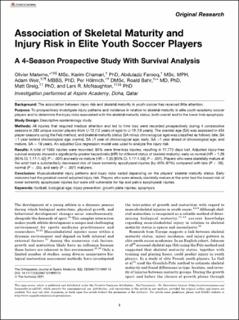| dc.contributor.author | Materne, Olivier | |
| dc.contributor.author | Chamari, Karim | |
| dc.contributor.author | Farooq, Abdulaziz | |
| dc.contributor.author | Weir, Adam | |
| dc.contributor.author | Hölmich, Per | |
| dc.contributor.author | Bahr, Roald | |
| dc.contributor.author | Greig, Matt | |
| dc.contributor.author | McNaughton, Lars R. | |
| dc.date.accessioned | 2021-12-08T12:10:31Z | |
| dc.date.available | 2021-12-08T12:10:31Z | |
| dc.date.created | 2021-06-17T12:35:15Z | |
| dc.date.issued | 2021 | |
| dc.identifier.citation | Orthopaedic Journal of Sports Medicine. 2021, 9(3), Artikkel 2325967121999113. | en_US |
| dc.identifier.issn | 2325-9671 | |
| dc.identifier.uri | https://hdl.handle.net/11250/2833347 | |
| dc.description | This open-access article is published and distributed under the Creative Commons Attribution - NonCommercial - No Derivatives License (https://creativecommons.org/licenses/by-nc-nd/4.0/), which permits the noncommercial use, distribution, and reproduction of the article in any medium, provided the original author and source are credited. You may not alter, transform, or build upon this article without the permission of the Author(s). | en_US |
| dc.description.abstract | Background: The association between injury risk and skeletal maturity in youth soccer has received little attention.
Purpose: To prospectively investigate injury patterns and incidence in relation to skeletal maturity in elite youth academy soccer players and to determine the injury risks associated with the skeletal maturity status, both overall and to the lower limb apophysis.
Study Design: Descriptive epidemiology study.
Methods: All injuries that required medical attention and led to time loss were recorded prospectively during 4 consecutive seasons in 283 unique soccer players from U-13 (12 years of age) to U-19 (18 years). The skeletal age (SA) was assessed in 454 player-seasons using the Fels method, and skeletal maturity status (SA minus chronological age) was classified as follows: late, SA >1 year behind chronological age; normal, SA ±1 year of chronological age; early, SA >1 year ahead of chronological age; and mature, SA = 18 years. An adjusted Cox regression model was used to analyze the injury risk.
Results: A total of 1565 injuries were recorded; 60% were time-loss injuries, resulting in 17,772 days lost. Adjusted injury-free survival analysis showed a significantly greater hazard ratio (HR) for different status of skeletal maturity: early vs normal (HR = 1.26 [95% CI, 1.11-1.42]; P < .001) and early vs mature (HR = 1.35 [95% CI, 1.17-1.56]; P < .001). Players who were skeletally mature at the wrist had a substantially decreased risk of lower extremity apophyseal injuries (by 45%-61%) compared with late (P < .05), normal (P < .05), and early (P < .001) maturers.
Conclusion: Musculoskeletal injury patterns and injury risks varied depending on the players’ skeletal maturity status. Early maturers had the greatest overall adjusted injury risk. Players who were already skeletally mature at the wrist had the lowest risk of lower extremity apophyseal injuries but were still vulnerable for hip and pelvis apophyseal injuries. | en_US |
| dc.language.iso | eng | en_US |
| dc.subject | apophysis | en_US |
| dc.subject | biological age | en_US |
| dc.subject | football | en_US |
| dc.subject | growth plate injuries | en_US |
| dc.subject | injury prevention | en_US |
| dc.title | Association of skeletal maturity and injury risk in elite youth soccer players: A 4-season prospective study with survival analysis | en_US |
| dc.type | Peer reviewed | en_US |
| dc.type | Journal article | en_US |
| dc.description.version | publishedVersion | en_US |
| dc.rights.holder | © The Author(s) 2021 | en_US |
| dc.source.pagenumber | 11 | en_US |
| dc.source.volume | 9 | en_US |
| dc.source.journal | Orthopaedic Journal of Sports Medicine | en_US |
| dc.source.issue | 3 | en_US |
| dc.identifier.doi | 10.1177/2325967121999113 | |
| dc.identifier.cristin | 1916401 | |
| dc.description.localcode | Institutt for idrettsmedisinske fag / Department of Sports Medicine | en_US |
| dc.source.articlenumber | 2325967121999113 | en_US |
| cristin.ispublished | true | |
| cristin.fulltext | original | |
| cristin.qualitycode | 1 | |
